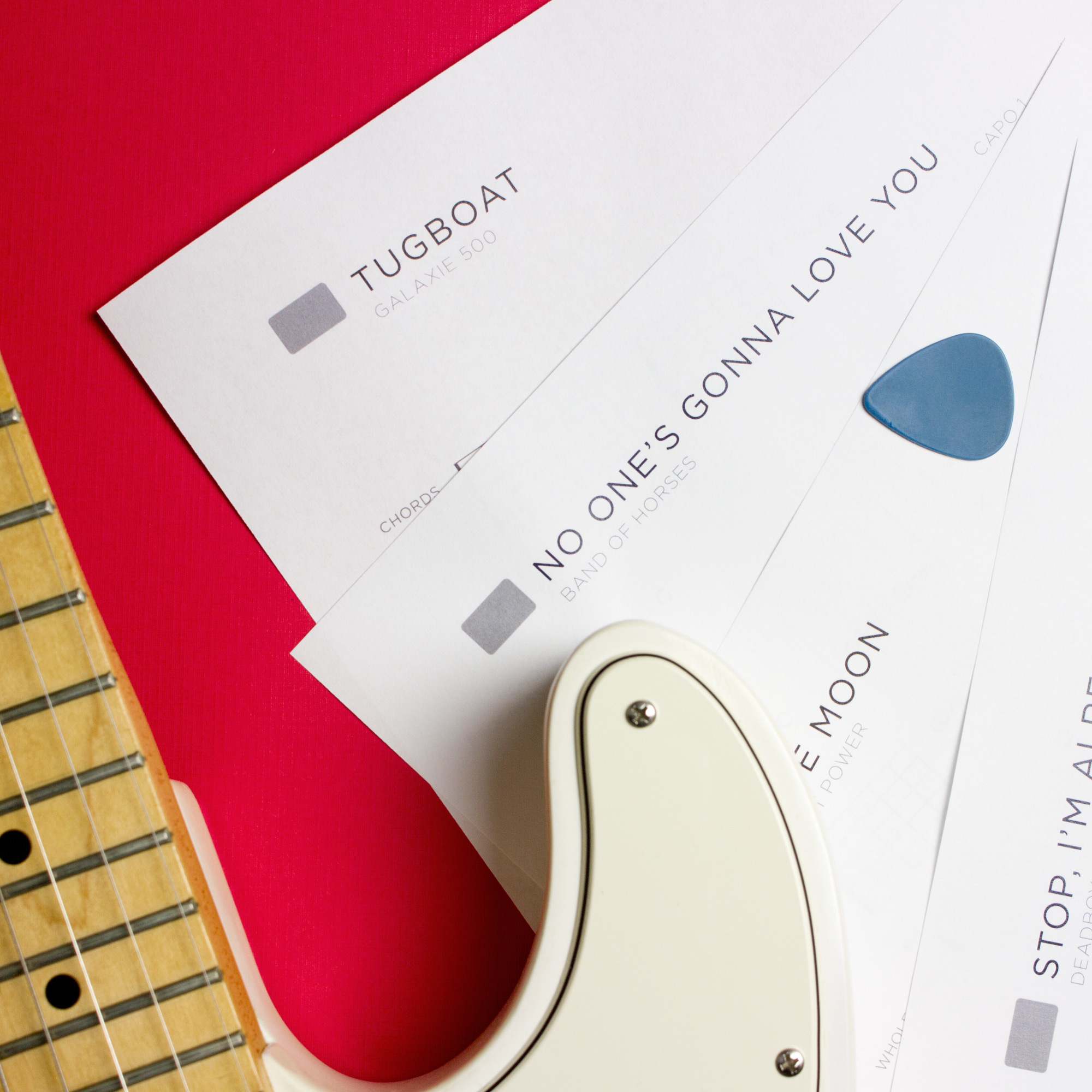Learn Dead Flowers, by The Rolling Stones, on guitar
This post is a tutorial on how to play Dead Flowers, by The Rolling Stones on guitar.
I've rated this tutorial to be at about a 2/10 difficulty rating because this song uses three chords, the D–A–G chord system as I like to put it, and has one strumming pattern throughout the entire song. I suggest that you have about 5 songs under your belt before you start learning this song.
I'll be showing you a transcription of how to play Dead Flowers. There are two guitars in this song, an electric guitar and an acoustic rhythm guitar. I'll be showing you how to play the acoustic rhythm guitar part.
What skills are required? What are the benefits to learning Dead Flowers?
Dead Flowers is a moderately paced, easy-to-play song that uses only the chords D, A, and G. This song also uses the folk strum. What I particularly love about this song is that it excellent for understanding the cues of a song, i.e. the things that the people in the band to prepare for and warm up the next section of the song.
I think having some familiarity with the D–A–G chord system is an excellent idea as well as having some experience with the folk strum. If it were me teaching you, I probably wouldn't show it to you until you had about five songs under your belt. Why? Well, there are easier songs out there. If you don't believe me, try out some of my 0/10 songs or my 1/10 songs before you give Dead Flowers a shot.
Highly recommended: Download a copy for yourself
It might be difficult to feel bad about stealing music from The Rolling Stones, but they were poor once. They really had to fight for their music, for their living. Yeah sure, they are rich now, but what are you getting from just streaming their music? Not much. If you had your own copy, you could pop the song into Capo and slow the music down while you're learning it. Beyond that, I think it's good karma. Here's some download links:
Getting familiar with and approaching Dead Flowers
Dead Flowers has one strumming pattern, a verse, and a chorus. If you aren't playing the verse, you're playing the chorus, and vice versa. It's not too complicated. That being said, I know the value of becoming familiar with a song before playing it. If I could turn back time, this is exactly what I'd do more of.
To get started, I recommend that you spend time memorizing the lyrics, hear the differences between the verse and the chorus, and hum along to as many different melodies in the song as humanly possible (guitar solo included).
Approaching Dead Flowers
Okay, guitar time! We are going to work on the strumming pattern first, the chord progression for the verse next, the chorus, and then we'll wrap up with a discussion on the "cues" for the chorus, last.
Here's where you can find all these chunks on the YouTube video, (posted below for your convenience):
Strumming Pattern — 3:17
Chord Progression for Verse — 5:53
Chord Progression for Chorus — 7:11
Chorus Cues and Song Discussion — 11:29
Solidify the verse and the chorus separately
I will fully admit that it get on my nerves sometimes when students take things really fast without having spend the minute or two to solidify what they're working on at first. It doesn't take much time, and doing so really makes learning the song much faster.
If you have the chord progression and strumming for both the verse and the chorus together at a slow-ish tempo, it would do you well to solidify the mechanics of both of them before you put them together. I recommend playing it slower than you want to, at first. You can always speed it up later.
By the way, I do have a marvelous chord sheet of Dead Flowers available for you to look closely at, as you're practicing each section.
Push the tempo to destroy the chord progressions Separately
The verse is probably the more difficult for people to master. The idea here is to get used to the constant physical movement of the D–A–G–D chord progression. One way of practicing this is to play just one strum per chord, and then practice the chord progression with the strumming.
The faster you can move between the chords, the easier it will be for you to incorporate strumming (though there are some tricks I've guided students through to master chord progressions).
Play Four reps of the Verse, One Rep of the Chorus
The next thing to do is to get comfy playing the verse and the chorus right after each other. The trick is to start simple, like this:
- Play one rep of the verse and then the first two lines of the chorus.
- Play four reps of the verse and then one rep of the entire chorus.
See how you can build up your skill like that? It's easier on you in the end.
Play along with the Recording: Cues
If you can play the verse and chorus on their own, you can play these up to speed, and if you can play some reps of the verse and the chorus right after each other, you're ready to play along with the recording. To do this, you need to be ready to change to the chorus part when it comes. Listen for Mick Jagger singing "Take me down..." This is always sung before the chorus. If you hear those three words, you're about to change to the chorus. Bam!
Once you can play along with the recording from start to finish without thinking about it, you've got it! Congratulations! Yay!
Troubleshooting Dead Flowers
"The strumming pattern is totally tripping me up. Help!"
I'll be straight with you: Strumming is a hard skill to master in the acoustic rhythm guitar style. My recommendation would be to find a good guide (I can help you learn strumming really quickly). If you prefer to go it alone, this video should help you out.
"I've got the strumming pattern at a slower pace, but how do I take it faster?"
It's time to apply some workflows! With the right workflow, you'll learn in half the amount of time than will most other beginners. I've got a couple of suggestions: Try the Up 10 Down 5 workflow or High Edge workflow. These are easy ways to speed up anything you're working on in your guitar practice.
"The D to A progression is really hard. Help!"
Yes, this is. To get better, I suggest refingering your A chord like this:
- Middle finger, D String, Second fret.
- Index finger, G String, Second fret.
- Ring finger, B String, Second fret.
Doing this means that your index finger is anchored on the same string and fret for both of those chords. This chord photo set can show you how in all it's high-resolution glory.
"The D chord is super difficult to play."
Overall, there are seven basic chords that you can learn on guitar. D major is the second hardest of them. Have patience, and keep in mind that many beginners to guitar don't automatically play this chord correctly on the first shot. The more time you spend playing guitar, however, the easier it'll get.
Here's some tips for you:
- Play on your fingertips, only.
- Cut your fingernails.
- Try to be as close to the frets as you can, even with your ring finger (I know it's hard with the D chord).
- The thinnest string, the string closest to the floor, might not sound great right now. Be good to yourself and allow that string to remain muted until you become more familiar with it.
- If you can get three strings of this chord sounding good, that's good enough. Be good to yourself and relax if the chord doesn't sound all that great right now. If you enjoy playing guitar enough and stick with it, this problem will solve itself over time.
"I'm getting off-track with the chord progression in the verse. Help!"
There are four chords in the verse: D, A, G, and then D. The first D signals the start of the verse, the last D signals the end. The first D is like a capitalized letter of a sentence, and the last D is like the punctuation mark. The idea is to treat these D chords differently.
To treat these D chords differently, try this: For the very first strum on the first D chord, play it as hard as you can:
Also, keep in mind that I've put together a loop pack for this song that you can use to specifically isolate the guitar part in the verse.
"I'm getting lost in the chorus. Help!"
The first four lines of the chorus tend to not trip many people up, but it's the transition from the fifth line to the sixth line that does it. When you look at it, it's actually three D chord in a row, but are they really? No.
The final two D chord of the fifth line of the chorus are like the punctuation mark for that line, and the first D chord of the sixth line of the chorus is the capitalized letter of the new line. This probably didn't make much sense to you, so I included an audio sample. I highly recommend that you download the chord sheet I put together for this song and follow along starting at the fifth line:
"I'm losing track of how many repetitions I need to play in the verse before the chorus comes in."
You can count, or you can be lazy like the rest of us and listen for the cue.
Cues are specific musical flourishes that the band members do to prepare for a new part in the song. If you hear a cue, then you know a change in the song is coming. In this case, listen for Mick Jagger singing "Take me down..." This is always sung before the chorus.
Again, you can count repetitions, or you can just listen for the cue. As far as I'm concerned, the cues are far more enjoyable to listen to and will keep you more engaged with the music.
"This song goes so fast. How do I slow it down?"
It's not as hard as you might think. My suggestion is to apply a specific workflow, one of my personal favorites: Capo 10. This workflow will show you how to practice along with the song without getting behind.
"How will I know if I've mastered this song?"
When you play along with the recording, you've got this song. Yay!
Resources mentioned in this article
Heroin addiction and social climbing. What a song! Includes a custom designed song sheet, loop pack, and multiple chord photo sets.








